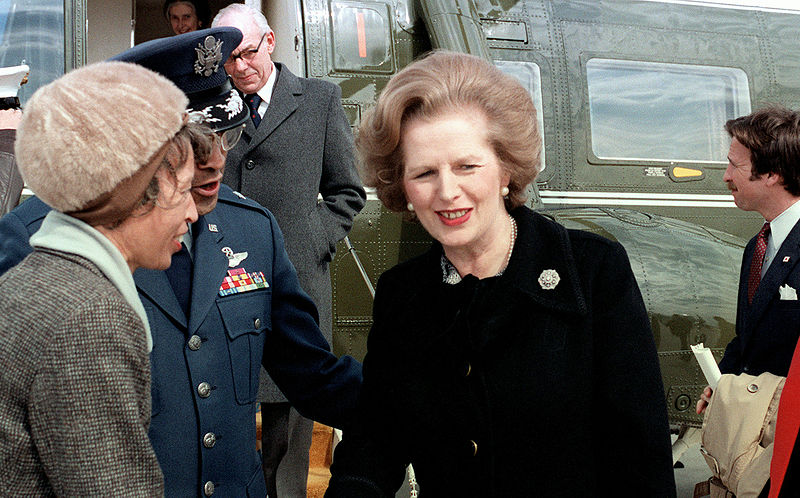 Print This Post
Print This Post- The Strategist - https://www.aspistrategist.org.au -
Maggie's Maddie
Posted By Graeme Dobell on January 22, 2014 @ 06:00
 The 2014 Madeleine Award for the use of symbol, stunt, prop, gesture or jest in international affairs goes to Margaret Thatcher.
The 2014 Madeleine Award for the use of symbol, stunt, prop, gesture or jest in international affairs goes to Margaret Thatcher.
I hope that people will say that I did the best with what I was given, tried to make my parents proud, served my country with all the energy I had, and took a strong stand on the side of freedom. Perhaps some will also say that I helped teach a generation of older women to stand tall and young women not to be afraid to interrupt.
The most important thing I have to say to you today is that hair matters. This is a life lesson my family did not teach me, Wellesley and Yale Law School failed to instill: Your hair will send significant messages to those around you. What hopes and dreams you have for the world, but more, what hopes and dreams you have for your hair. Pay attention to your hair, because everyone else will.
Margaret Thatcher's suspicions about the Foreign Office are legendary, though they have not always resulted in any very effective control of its policies. At times she seemed to regard it as a free-standing institution, independent of government. South Africa provided one example given to me. She had been persuaded, reluctantly, that British military attaches ought to be withdrawn. Sometime later, a Foreign Office minister, accompanying her at a meeting with an African statesman who complained about Britain's record in opposing apartheid, was astonished by the reply. First she ticked off what had been done: the Gleneagles agreement, no arms sales, and so on. Then turning to the FO man, she added: 'And they've withdrawn military attaches, whatever good that may do.
Mrs Thatcher reversed the usual etiquette of political praise. She kicked up and she kissed down. The ladies who served tea, the doormen, her beloved detectives could do no wrong; her ministers and senior civil servants must have sometimes felt they could do no right. An example of this was when a waitress at Chequers stumbled and poured soup into the lap of the Foreign Secretary. Mrs Thatcher jumped up and comforted the waitress!
For the next half-hour she took the eight of us on a tour of the public rooms, imparting with impressive assurance the history of this picture or that tapestry, anecdotes of what Pitt had done or Gladstone said. In the state dining-room with its rows of high-backed chairs, she said with a smile: ‘You know I had Giscard here last week. Where do you think I put him?’ We looked suitably baffled. ‘Here,’ she said, indicating a chair, and following her upward glance we saw on the wall opposite a full-length portrait of Lord Nelson next to a full-length portrait of the Duke of Wellington.
Article printed from The Strategist: https://www.aspistrategist.org.au
URL to article: https://www.aspistrategist.org.au/maggies-maddie/
[1] Image: http://www.aspistrategist.org.au/wp-content/uploads/2014/01/Margaret-Thatcher-US-visit.jpg
[2] took over the whole conversation: http://www.aspistrategist.org.au/margaret-thatcher-on-the-verge-and-after-the-bacon/
[3] hair styled 120 times in 1984: http://www.telegraph.co.uk/news/politics/margaret-thatcher/10541067/National-Archives-Margaret-Thatchers-120-hair-appointments-in-a-year.html
[4] hair-check on five consecutive days: http://www.independent.co.uk/news/people/news/the-iron-barnet-margaret-thatcher-had-118-hair-appointments-in-just-12-months-9036538.html
[5] Here is Hillary: http://www.nytimes.com/2001/05/21/nyregion/commencements-at-yale-mrs-clinton-ponders-hair-and-politics.html
[6] Thatcher perspective on her diplomats: http://www.amazon.co.uk/As-Seemed-Me-Political-Memoirs/dp/1857994256
[7] the evidence from her former speechwriter and political adviser, John O’Sullivan: http://quadrant.org.au/magazine/2013/05/margaret-thatcher/
[8] account of Mrs T showing his TV crew around 10 Downing Street: http://www.spectator.co.uk/features/thatcher-tribute/8884341/three-faces-of-thatcher/
[9] Valéry Giscard d'Estaing: http://en.wikipedia.org/wiki/Val%C3%A9ry_Giscard_d%27Estaing
[10] Wikimedia Commons: http://commons.wikimedia.org/wiki/File:Margaret_Thatcher_near_helicopter.jpg